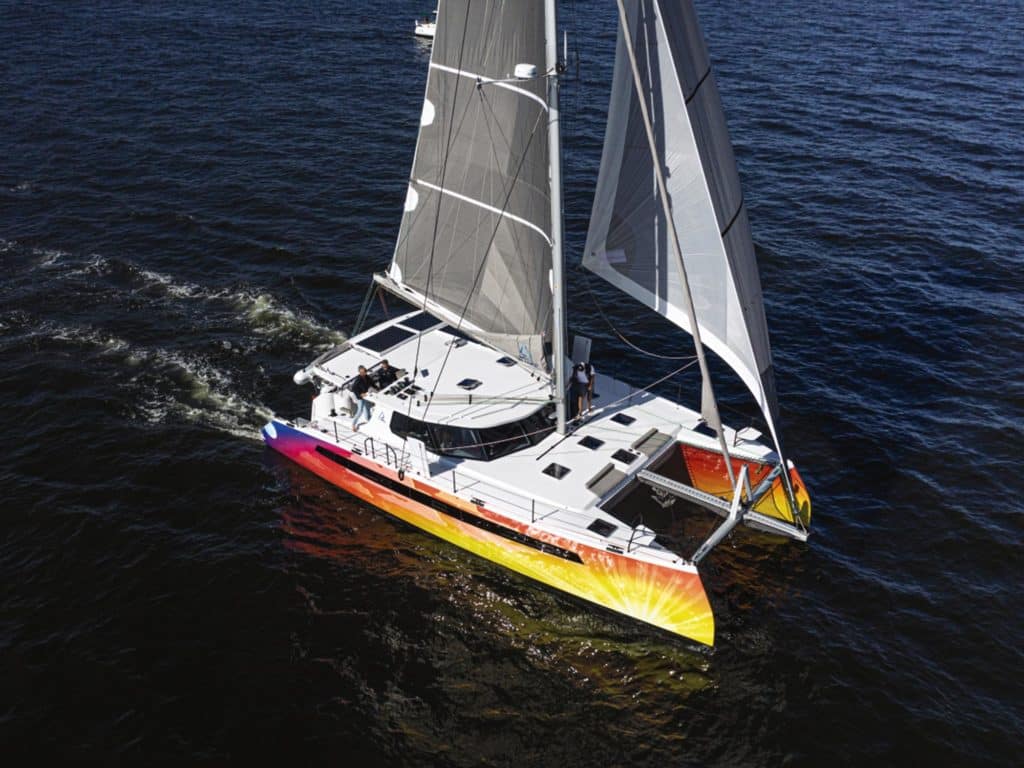
Today’s rich market of cruising catamarans spans a broad spectrum from payload to performance. On the one side are boats whose credentials as well-appointed floating condominiums outshine their sailing performance; on the other are souped-up hull-flying speedsters with load cells and dump buttons more suited to a young, athletic professional crew than to the average cruising couple.
For more than two decades, Phil Berman has sought to find a satisfying middle ground in the world of cruising catamarans. His latest offering, the Balance 482—with its downwind sail area of 2,900 square feet and a light-ship displacement of under 25,000 pounds on a 48-foot waterline—might not be the most extreme thoroughbred catamaran on the market, but it has power and sophistication, and a backstory worth understanding.
In 1999, Berman—Hobie Cat world champion of 1979, and a longtime sailor of cruising catamarans himself—founded the Multihull Company. Initially, it was a consulting service that served only as a buyer’s broker. Before long, though, he began taking listings on brokerage catamarans and hiring other brokers to serve a growing list of clients.
Over the ensuing years, Berman attended hundreds of surveys and sea trials of catamarans built by every major yard around the world. Along the way, he developed strong perspectives on what worked and what didn’t, in both production and design.
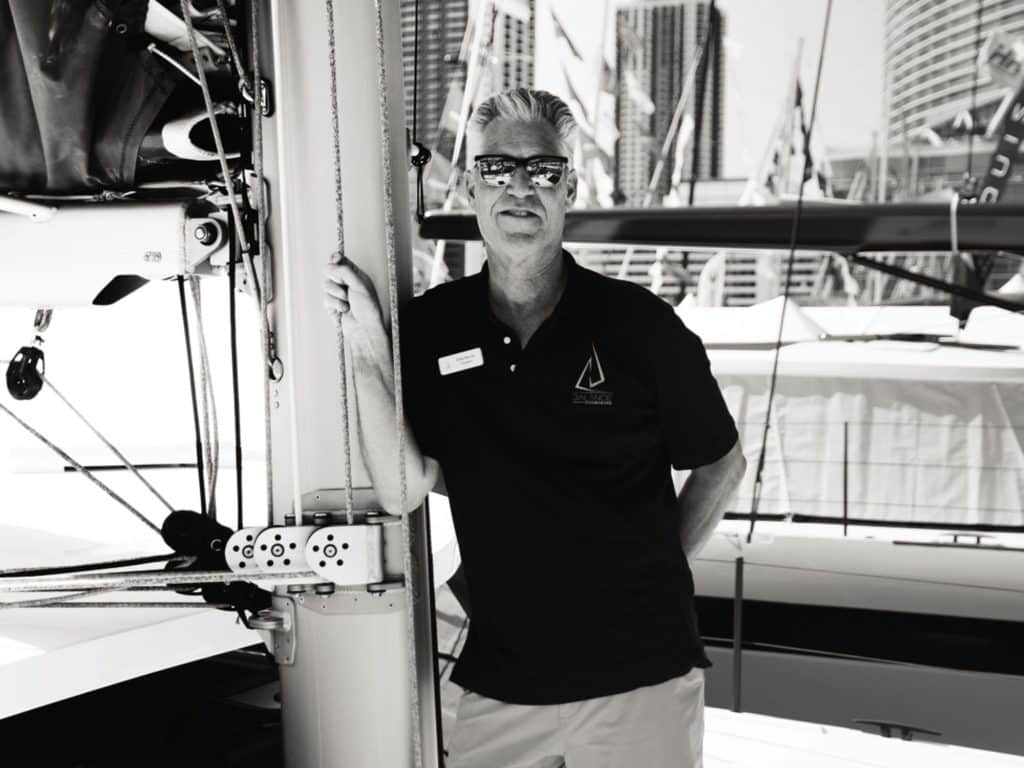
“I’ve never been a fan of balsa core,” Berman says, “particularly balsa-core decks. No matter what happens, you’re inevitably going to have water incursion in any fitting that’s attached through the deck, especially hatches.”
The fabrication and installation of bulkheads always catch his attention: “I think bulkheads should be made out of composite material, not marine plywood.” He prefers bulkheads cut on CNC machines to close tolerances and entirely tabbed with fiberglass. “Bulkheads shouldn’t be moving or floating,” he says. “I’d go on surveys, and I could hear them moving. I’d lift up floorboards, and I could stick a finger between the bulkhead and the hull, and it would get crushed if I left it there too long.”
It wasn’t just catamaran construction that bothered Berman, but also sailing performance. His big epiphany came during the sea trial of a 50-something-foot French production cat off Palm Beach, Florida.
“I was trying to go to windward in 17 knots of wind,” he says. “I couldn’t sail faster than 6½ knots, and I couldn’t point higher than 55 degrees. I just had this weird revelation: Like, man, we’ve lost the balance. And that was the day when I decided that I really ought to try to design a different kind of catamaran.”
Of course, not every catamaran he saw turned him off. For a few years in the early 2000s, he imported the French-built Switch 51. “I loved that boat in its day,” Berman says. “It was foam core with composite bulkheads, handmade foam-core furniture. It had nice living accommodations in the hulls, and it was physically attractive.” And it sailed well.
In the middle of the 2000s, Berman distributed Dolphin Catamarans, designed in France by Philippe Pouvreau and built in Brazil by Junior Pimenta. Those boats came close to the balance Berman was looking for, but they still had things he wanted to change.
“I did some redesign on that boat, but the one thing I learned is that once you tool a boat, you can’t go back,” he says. “Changing tooling is so costly.”
From 2008 to 2011, Berman represented Catana in the United States. By then, he knew that in the cats that sailed well, daggerboards were a common denominator, not shallow-draft fixed keels. Still, there was one detail common to the French performance catamarans that irked him: “All the French thought you had to have two wheels out on each hull. That was the sporty way to go. But I always looked at it as an affectation, because if you’re voyaging, you’re not standing there or sitting there steering your boat; you’re on autopilot. But when you do have to steer your boat, when you have to come into a harbor, or if you’re daysailing, you have this massive exposure—either to the cold or the wet or the sun.”
Berman’s strong preference for true cruising cats was a single bulkhead-mounted helm station. But even that idea had its problems.
“What was really evident to me was that on smaller or medium-size boats, you had to pop up some kind of enclosure over it with isinglass for foul-weather sailing,” he says. “And it’s in the wrong place to be sailing because you’re higher up in the fulcrum, and you have to walk up and down there. Aesthetically, that’s a disaster. I like things to be clean and elegant, spare and unadorned. Understated is always better, you know?”
These were some of the ideas that Berman pulled together when he started Balance Catamarans a decade ago. In fall 2013, he brought the first of these cats to the US boat-show circuit: the Balance 451. Designed by Roger Hill in New Zealand and built by Lee Xiangong in China, the 451 exhibited some of the DNA we see in today’s Balance cats: slim hulls, wave-piercing bows, composite bulkheads, and foam-cored hulls, deck and hardtop. At the time, Cruising World’s Boat of the Year judges saw a lot to like in that boat, but also saw evidence of a designer, builder, creator and boat owner from three continents pulling in different directions. “I would have done this differently,” was a common refrain we heard.
With the South African-built 526, Balance Catamarans hit its first home run in the eyes of the Boat of the Year judges—winning not only its category, but also the overall prize in the 2017 contest.
“We’re not creating a charter cat, and we’re not creating a racing cat,” Berman said at the time. “We’re creating a high-performance cruising cat for a couple to sail on.”
In the Balance 526, he had found the ideal middle path he’d been seeking all those years.
The Cape Town Connection
Evident in the Balance 526 was a wholesome partnership. To create that boat, Berman worked with builders and a designer who’d all grown up together in South Africa on the outskirts of Cape Town. Brothers Jonathan and Roger Paarman—world-class surfers and composites experts—and a couple of others had founded Nexus Yachts in Cape St. Francis in 2007. Before that, Jonathan had learned the composites trade by building surfboards and Hobie Cats in the 1970s, and then ran the factory floor for Voyage Yachts in the early 2000s. Over the years, Jonathan built Gunboats and other performance boats of carbon fiber and epoxy, including some that sailed in the Volvo Ocean Race.
Designer Anton du Toit also came by his trade honestly, sailing around the world with his family for 14 years, beginning at age 13. Through those years, he worked in boatyards, getting to know boats from the bottom up. Later on back in Cape Town, he worked for designer Angelo Lavranos and boatbuilder Southern Wind.
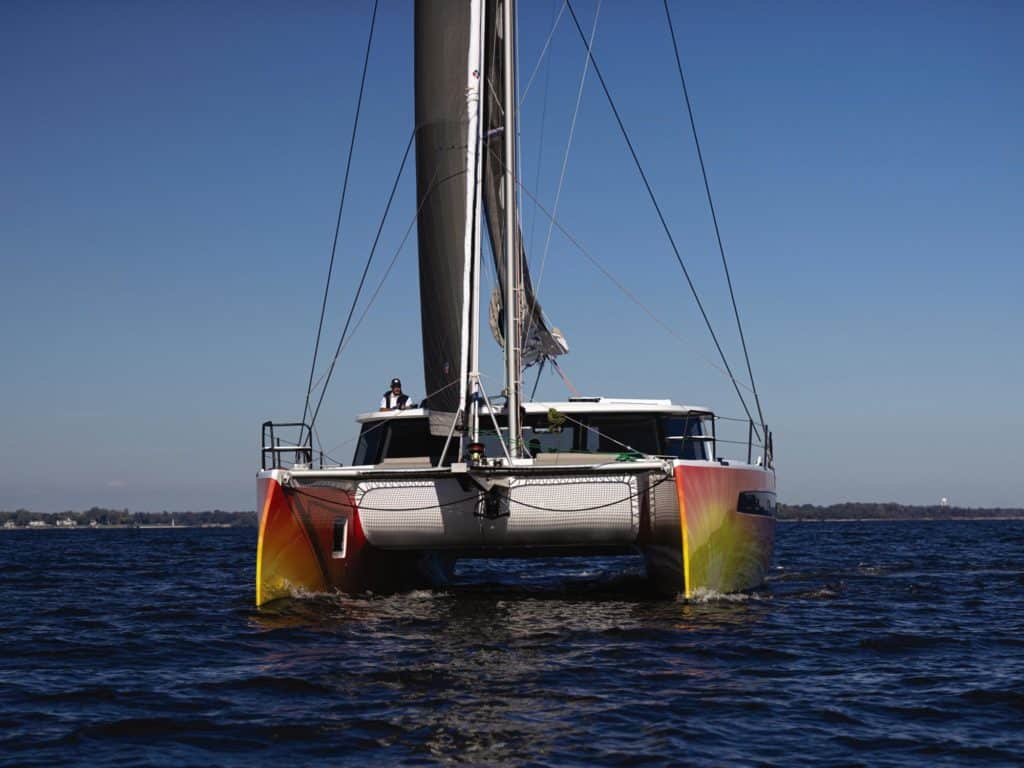
A close look at the Balance 526 reveals multiple creators working together, and all pulling toward a single goal without clunky compromises. Around the time the first 526 hull was launched in 2015, Berman described the different build processes: “In China, Lee Xiangong builds our boats. Lee went to a university of boatbuilding, but he isn’t a lifelong sailor. Lee is going to do exactly what I tell him to do.”
The result was that communication took longer, particularly when the New Zealand-based designer got looped in, and it took longer to finish any given project.
Working with his South African partners was different. “Jonathan Paarman isn’t going to do exactly what he’s told to do,” Berman says. “If he thinks something is stupid, he’s going to let me know about it right away—because he’s a sailor. He intuitively knows.”
Clean lines are the defining trait of the Balance brand, beginning with the 526. For that model, Berman and du Toit started from the sailing performance they wanted the boat to achieve: steady speeds of 10 to 12 knots in ocean-cruising mode with a shorthanded crew (and with potential for higher speeds when pushed). The way to achieve that, they determined, was to keep the hulls’ beam-to-length ratio at 1-to-12. Other builders employ chines or bumps above the waterline to create more interior volume for wide fore and aft island berths in every stateroom, but the Balance team chose a form with clean lines that wouldn’t impede the flow of water over the hull.
Trade-offs from the narrow hulls are evident in the raised athwartships king berths forward, as well as steps down into the hull that require you to start with your right foot as you descend. Boat of the Year judges found these to be elegant compromises in light of the boat’s exemplary sailing behavior.
Construction of the 526 is a sandwich of fiber over a core of closed-cell foam. The fibers are E-glass with carbon reinforcement in the high-load areas. Given that the cost of carbon fiber is several times that of fiberglass, this was a reasonable choice for a boat that isn’t intended to compete at the grand-prix level.
That said, the resin throughout the boat is all epoxy—the best boatbuilding resin available. The cores are vacuum-bagged for thorough bonding throughout the structure; this includes such smaller parts as interior bulkheads and furniture. The result is a good blend of above-average strength-to-weight ratios and cost containment.
It’s a boat that takes 25,000 labor-hours to build, nearly five times that of a similar-size catamaran from a high-production builder. The Nexus yard has the capacity to build four 526s per year.
The 526 was the model in which Berman solved one of the catamaran market’s most vexing problems. What about the helm? On some cats, the helm exposes the sailor too much to the elements; on others, it isolates the helmsman from the rest of the crew, or it dangerously impedes visibility.
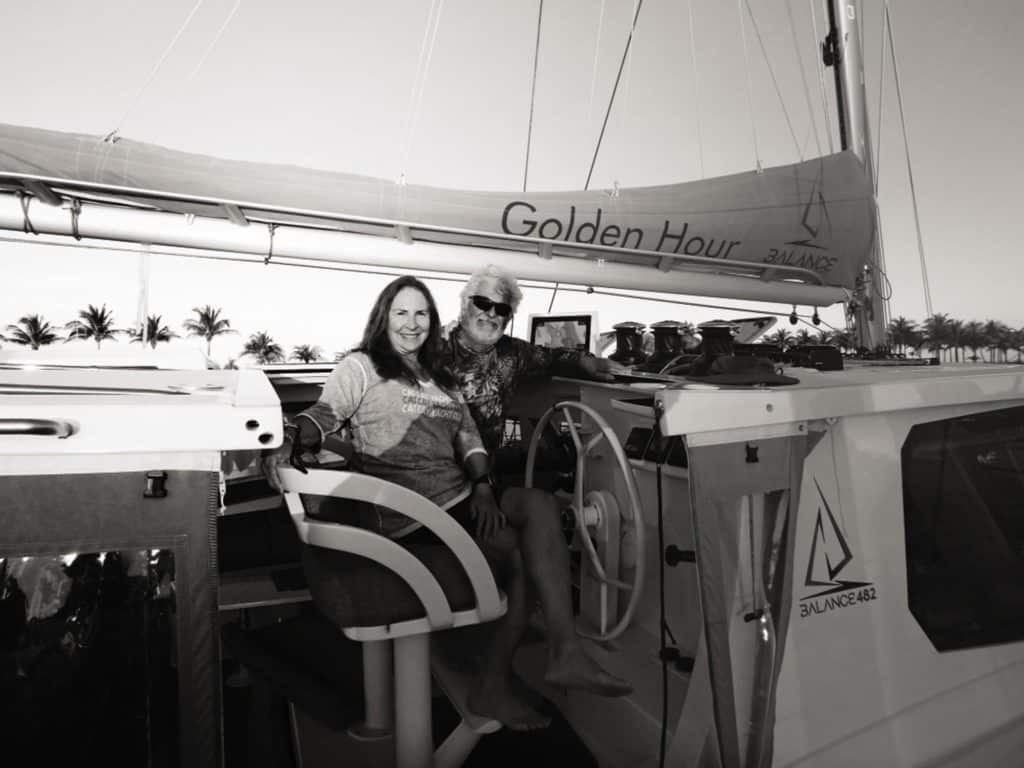
The Balance’s Versahelm is a single articulating pedestal that can be pinned in different positions: up above the cabin top, with full view of the sail plan and in easy reach of all sailhandling controls; or down at the level of the cockpit sole, where the helmsperson has full protection from the elements, and full visibility through the saloon windows to all four corners of the boat.
The Balance 482, which debuted at the 2021 United States Sailboat Show in Annapolis, Maryland, is an entirely new boat that retains fundamental traits from the Balance 526, but it takes the cost-containment steps a bit further.
“The Balance 482 is a scaled-down version of the 526, but it’s a newly engineered and newly tooled boat,” Berman says. “We took all the learnings of the 526 and packed them into this boat. One goal of this boat was to find a way to bring the price down from the 526. This is a vinylester foam-core boat, whereas the 526 is an epoxy boat. And we’re using more molded parts. The 482 runs about $400,000 less than the 526.”
For the Balance 482 and a newer 44-footer set to debut in the US this fall, Balance is working with Cape Town builder Mark Delaney. He’s a second-generation boatbuilder who studied marine technology in the United States and then returned to Cape Town to join his father in running Two Oceans Marine, which the elder Delaney founded in 1989 to build semiproduction power catamarans. Over the ensuing years, Two Oceans transitioned to building high-end custom powerboats and sailboats from 70 to 110 feet. Projects included sophisticated yachts built of carbon fiber and epoxy.
Working with Berman, Delaney started a new company called Balance Catamarans Cape Town to build the Balance 482 and Balance 442. “We’re gearing up to build 12 boats of each model a year,” Delaney says. “Eventually, 18 boats per year is where we’d like to get to.”
Delaney’s boatbuilding operation employs 400 staff and, with rare exceptions for specialized tasks, does everything in-house, including electrical systems, painting and interior furniture. Part of the cost-containment regimen for the 482 and 442 models is to use polyester and vinylester resin instead of epoxy, which is four times more expensive. But because Delaney’s production line is set up to build in epoxy, the yard is able to use some of those practices in the 482 and 442.
Post-curing is also part of the build process, heating the composite parts after layup to mitigate print-through months and years down the road.
“We still post-cure the hulls like we would on epoxy boats just to try to help, because all these guys are painting their hulls,” he said. “It gives the boat a little more protection against the UV.”
Delaney’s lamination team also takes the step of “thermoforming” the PVC foam core. The traditional method for making flat sheets of foam take the complex curves of a sailboat hull is to score the foam, leaving open channels called “kerfs,” which the resin then fills during layup. By contrast, thermoforming starts with uncut foam, to which the laminators apply heat to take the curves. Together with vacuum-bagging, this technique ensures a thorough bond between fiber and core without the added weight in resin to fill all the kerfs.
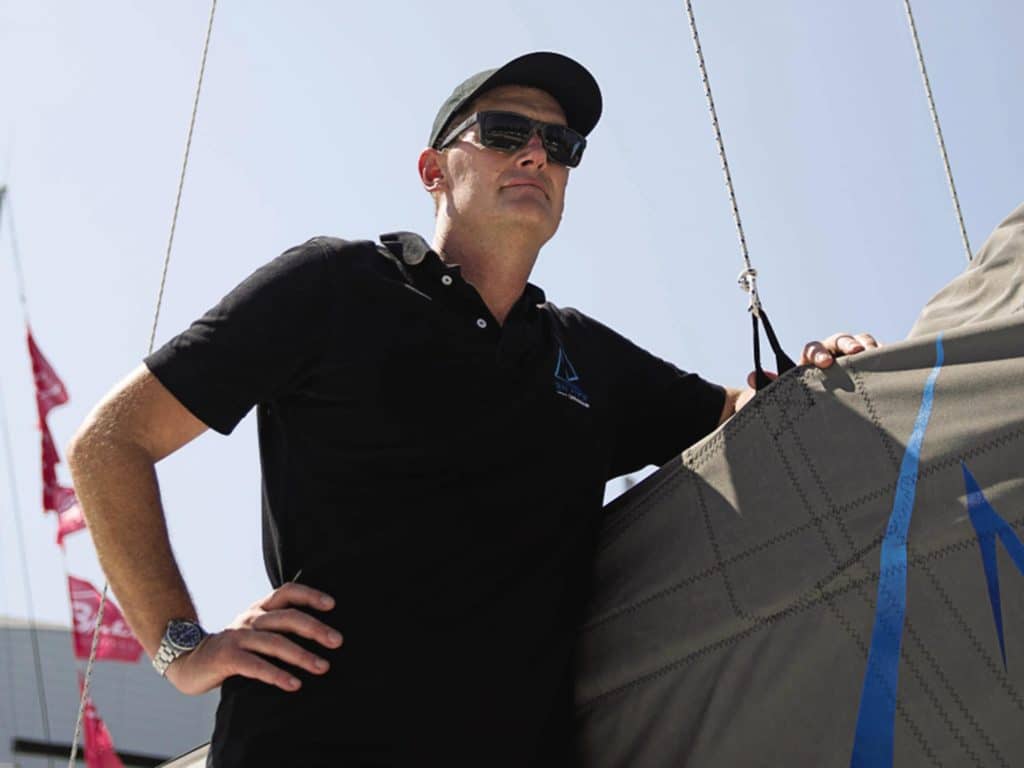
The result? “The sailing performance was excellent,” said 2022 Boat of the Year judge Gerry Douglas, “and the structure of the boat throughout was exemplary.”
Flattening the Learning Curve
This was the boat and these were the relationships Kevin and Sandy Hutton took on when they ordered Hull No. 1 of the Balance 482. In fact, in Kevin’s case, the relationship went back further than that—to the Southern California Hobie Cat circuit of the late 1970s.
“Phil Berman and I had a lot of parallels because he worked at Hobie Newport and I worked at Hobie Long Beach,” Kevin says. “I was the snotty kid looking up at the guy who was winning all the races.”
Sandy, a longtime powerboater, was no stranger to complex machines, but a performance cruising catamaran was new.
The couple brought different backgrounds to the process of learning to run the boat. Sandy had worked as a flight nurse and knew about the design of complex machines from her time at Bell Helicopters dealing with aircraft for medical evacuations. Kevin’s background was in emergency medicine and flight medicine; he and his brother and father had bought and restored a series of down-and-out sailboats, culminating with a Catalina 400 they owned for many years and sailed along the California coast.
To learn the Balance 482, they hired Richard and Jessica Johnson, both licensed captains, former Sea Education Association instructors, and two-time circumnavigators. The four of them went sailing for a week this past winter, after the boat was shipped from Cape Town to Fort Lauderdale, Florida.
“It got off the ship on October 4, and we had to be in Annapolis for the boat show by October 12, so we power-sailed up the coast, and got there in four days and 17 hours,” Kevin says.
They’d made it around Cape Hatteras just before a 60-knot blow that thrashed other boats making the same trip just behind them.
“We really shook her down,” Kevin says. “That was her first passage, and it was the roughest passage I think I’d ever sailed in. We came up the Chesapeake double-reefed and with the jib, and we were doing like 12 knots beating into the wind. It was lovely going—everything that was promised. It gave me a sense of confidence in the boat, knowing she could take that beating.”
Today, they’re relishing the relationships they made throughout the project of building the boat. “This all started just as COVID kicked in,” Kevin says. “We were all supposed to go to South Africa in August 2020. Everything had to shift to virtual. But I can’t say enough about Mark and his team, who really made it as seamless as you can. We got weekly reports. We’d schedule calls on Zoom or WhatsApp, and Mark would just be standing on our boat, walking us through it. So in some ways, we almost got to be more part of it.”
Through their blog, they’ve gotten to know many of the other Balance owners.
I met Kevin and Sandy in the Bahamas this past February in the middle of their training week. For more than 20 years, Kevin has served as a physician at the all-volunteer medical clinic on Cat Cay, a private club. He now directs the clinic.
The Huttons had been sailing all night from Fort Lauderdale and hadn’t slept all day, instead using the daylight to practice anchoring and other techniques with the Johnsons. That night over a dinner of fish tacos, they were awake and alive and ebullient about the adventures and the community they were stepping into.
Sandy was still on her big learning curve, such as when she was on watch during the entry into Cat Cay harbor, being shown tips and techniques that included use of the chart plotter. Just as they approached the harbor entrance, she juiced the engine throttle.
“What are you doing?” the instructor asked.
“You said, ‘Zoom in,’” she replied.
Clearly, the Huttons are poised and ready to have some fun on the water. “I probably need a good solid year of getting comfortable,” Sandy says. “I think it’s just going to be a balance of how much time to be away from home, I can see myself wanting to spend more time on the boat.”
Specifications
| LOA | 48’3″ |
|---|---|
| LWL | 48’3″ |
| BEAM | 225’11” |
| DRAFT | 3’11″/7’3″ |
| DISPL. | 24,950 lb. |
| SAIL AREA | 1,432 sq. ft |
| D/L | 99 |
| SA/D | 26.8 |
| PRICE | $1,450,000 |
484-413-2132
balancecatamarans.com
Tim Murphy, CW editor-at-large and longtime Boat of the Year judge, visited Nexus, Two Oceans and other South African boatyards in 2015. (See “Artisan Cats of South Africa,” July 2016.) He sails his 1988 Passport 40, Billy Pilgrim, on the US East Coast and in the Bahamas.








